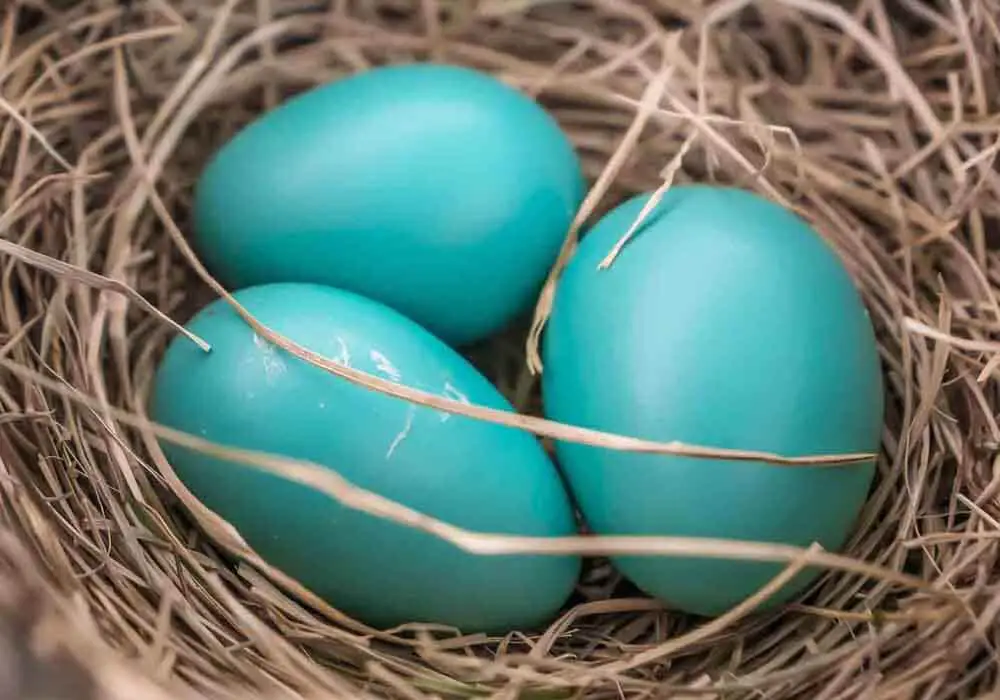Robin Egg Facts
There's More To Them Than Just Their Pretty Color
Robins are lovely birds, famed for their warm red bellies and beautiful songs. However, what they are more commonly known for are their unique eggs. What are some robin egg facts?
Robin eggs are small in size and have speckled, sky-blue shells. These birds have unique nesting habits and lay about three eggs on average from spring to late summer. Healthy robin eggs that are cared for properly will hatch into baby birds.
The rest of this article will tell you everything you need to know about robin eggs to enrich your understanding of these marvelous creatures and their habits. Read on to learn more about robin egg facts.

When Do Robins Lay Their Eggs
There’s something so rewarding about spotting a bird's nest in your yard or local woods. If you’re interested in finding an occupied robin’s nest, you might wonder when exactly robins lay their eggs.
Robins lay their eggs in the spring until late summer, typically from April to August. While some birds may lay their eggs a bit earlier or later, depending on the climate and other environmental factors, this time frame is generally universal for most North American robins.
A robin will usually lay their eggs after they’ve eaten for the day. If they’re able to find worms early in the morning, they will lay their eggs soon after.
For robins, the breeding season usually begins in March—so the earliest eggs will be ready in about April. robin egg facts
How Often Do Robins Lay Eggs?
Robins lay eggs often, about two broods every year on average. However, some robins can lay up to four during some breeding seasons, though this is less common. A robin will lay each clutch in increments of one egg per day.
A female robin will lay eggs from when she is about one year old to the end of her life. The average lifespan of a robin in the wild is up to six years—double that in captivity. However, it’s more common for a robin to survive as little as two years in the wild due to predators, illness, lack of food, and other environmental factors.

From egg to adult a Robins life is a fascinating thing. We've written an article that follows it from the beginning, so come along for the journey and check out our article about the Robins life cycle here.
How Many Eggs Does a Robin Lay?
Robins lay many eggs each breeding season. On average, they lay one or two broods yearly, but some can lay up to four. There are about three to four eggs per clutch, sometimes up to six.
A robin will lay her clutch one egg at a time, with about one egg every day, until there are no more eggs to lay.
Because it’s so rare for a wild robin to survive long enough to die of old age, you can expect that your average female robin will lay eggs for most of her lifetime, usually 2-6 years.
Let’s do a little math.
If a robin lives for two years and lays one clutch of three eggs every breeding season, this is six eggs a year.
However, if they live six years and lay three clutches of six eggs every breeding season (four clutches is possible but rare)—this is a lot of eggs.
As you can see, the number of eggs a robin will lay in her lifetime can vary quite a bit. It depends on her health and the quantity, quality, and consistency of resources she can access. Genetics will also play a factor.
How Big Is a Robin Egg?
When you picture a robin egg, you probably think about how small they are. Robin eggs are an iconic part of nature and are known for their unique color and tiny size. But how small are they, exactly?
A robin egg is not big. These eggs are usually tiny, measuring just under 2 inches in length and less than 1 inch in width. They can fit in the palm of your hand and don’t weigh more than a quarter.
The average robin egg size is 1.1-1.2 inches (2.8-3 centimeters) in length and 0.8 inches (2.1 centimeters) in width.
Because these eggs are so small, robin nests are not much bigger, either. A robin nest is usually no less than 8 inches (20 centimeters) in diameter. This size is also small enough to fit in your hand.
Do Robin Eggs Get Bigger?
Robin eggs do not get bigger. A baby robin is born in a shell that is big enough to contain them until they are ready to hatch. When they develop enough to hatch, this usually means that they have outgrown their egg size.
Baby robins develop from when their eggs are laid to when they hatch through their shells. The egg will get heavier as the bird grows, but the shell will not develop in size.
Ever See A Baby Robin Hatch?....Awww!
How Can You Identify a Robin Egg?
You can identify a robin egg by size, color, weight, time of year, and location. They are one of the only birds in North America that lay sky-blue eggs, so this is usually the best factor to determine whether an egg belongs to a robin.
If you see a nest filled with about three to four small blue eggs in the spring or late summer, and the eggs only weigh about as much as a quarter, you can be confident that the egg belongs to a robin. Their eggs also tend to have speckle patterns, so keep an eye out for this.
However, it would help if you also researched your specific region to see whether or not robins live in your area. If the answer is no, it might belong to a different kind of bird.
Why Are Robin Eggs Blue?
Robins are famous for their brightly colored eggs. But why are robin eggs blue, exactly? Let’s discuss this.
Robin eggs are blue because a pigment called biliverdin coats their shells. Healthier females will lay the brightest eggs, while paler robin eggs can signify a less-healthy parent or child.
Believe it or not, scientists have recently discovered that this pigment can help protect developing baby birds from harmful UV radiation while they are still embryos. The darker the coloring—the more protection it provides a baby bird.
How To Tell if a Robin Egg Is Alive?
If you’ve found a robin egg in your yard and want to know if the egg is still alive, there are a few things you can do to check.
To tell if a robin egg is alive, you first need to check for damages and marks. It’s a good sign if the egg is smooth and free of external defects. You can also use a flashlight to view the embryo through the shell. A healthy robin egg will also be warm.
One thing to note is that if you find a stray robin egg and it’s warm, this doesn’t necessarily mean it’s still alive. It would be best if you still double-checked in other ways.
If you know where to locate its nest, you can also keep an eye on it to see if a female robin is still visiting the nest to care for her young. If not, there could be a chance the clutch has died, and the egg you found has faced the same fate.
It’s imperative to remember that you shouldn’t take robin eggs from a nest or even touch them. This contact can sometimes cause a mother to reject her young and stop caring for them, which can be fatal to the developing baby birds.
However, if the egg you find appears to have fallen or looks abandoned, this is when you should gently check for signs of life.
If you find a stray robin’s egg and think it could still be alive, it’s best to contact your local bird rescue if you have one in the area. They can assess the situation and help care for the egg.
If you don’t have one nearby, you can still contact a bird rescue close by, and they can advise you on the proper steps to take to ensure the egg gets the best possible care. You might have to care for the egg yourself.
How Long Does It Take To Hatch a Robin Egg?
It takes a robin egg about 13 days to hatch after it’s laid by the mother. If the egg is incubated correctly and watched over by its mother, it should hatch in this two-week timeframe.
If an egg is not cared for properly or the embryo is unhealthy, the bird might not hatch this quickly or not at all. Delayed hatching can result from the following:
- Infertility
- Inclement weather conditions
- Chemicals
- Eggshell damage
It’s not typical for a baby bird to hatch prematurely. They must fully develop to obtain the natural ability to hatch through an egg.
What Percentage of Robin Eggs Survive?
The percentage of robin eggs that survive is only 40%, unfortunately. This low rate is because many internal and external factors can decrease a baby bird’s chances of survival.
Factors that influence a robin egg's survival include the following:
- Infertility or genetic issues
- Inclement weather conditions
- Inadequate incubation
- Physical eggshell damage
- Toxic chemicals in the environment
- Predators

Who doesn't want more Robins in their yard?? This helpful article of mine enlightens on How To Attract Robins To Your Garden Or Yard.
Robin Egg Facts...Final Thoughts
Robins are fantastic little birds that produce beautiful blue eggs. These eggs are unique and have natural defense mechanisms that protect the embryo while developing. Robins have fascinating and instinctive behavioral patterns that you can observe in how they care for their eggs.
Hopefully, this article has strengthened your understanding of robin eggs, so you can fully appreciate these birds when you spot one in your yard.
Back To the TOP Of This Robin Egg Facts Page

About the Author...
Richard Worden, a dedicated bird lover for over 20 years, I love to share my in-depth knowledge and passion for birds. Read more About Me and my expertise in this field.
- We Know Birds HOME ›
- Robin Facts and Information ›
- Robin Egg Facts
